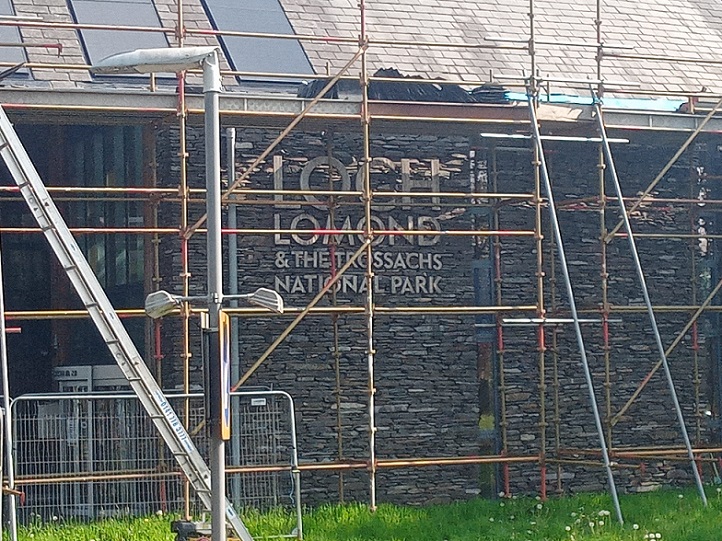
On 22nd November the Loch Lomond and Trossachs National Park Authority (LLTNPA) issued a news release announcing it was investing £1.6m of Scottish Government funds in its facilities over the winter in order for it to become a “net zero” organisation by 2030. The bulk of the money was earmarked for “retrofitting” the LLTNPA’s HQ at Carrochan which had been closed two weeks earlier:
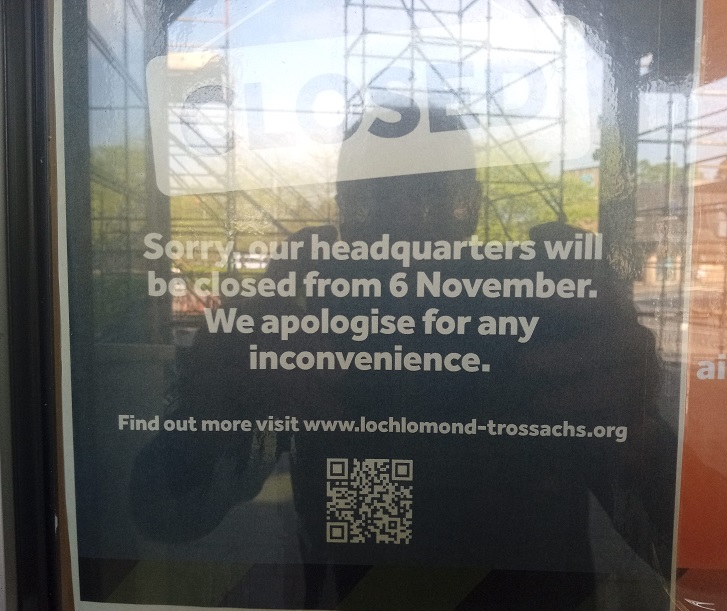
Perhaps the absence of anywhere for staff to work explains the late news release? Maybe too this explains why the contract award notices, for the installation of a heat pump to replace wood biomass heating system (see here) and to add solar panels to the roof (see here), weren’t published until 15th November AFTER the work appears to have started?
At the December LLTNPA Board Meeting senior management confirmed what was said in the news release about the work being undertaken over the winter and claimed they were on track and due to be completed by mid-March:

The progress report to the Board Meeting on 11th March indicated timescales had slipped slightly to the end of the month with snagging work due to continue into April:

Either LLTNPA senior management were not supervising the contract properly or they were concealing more serious problems from their Board because by May Carrochan was still very much shut and there was little sign of building work:
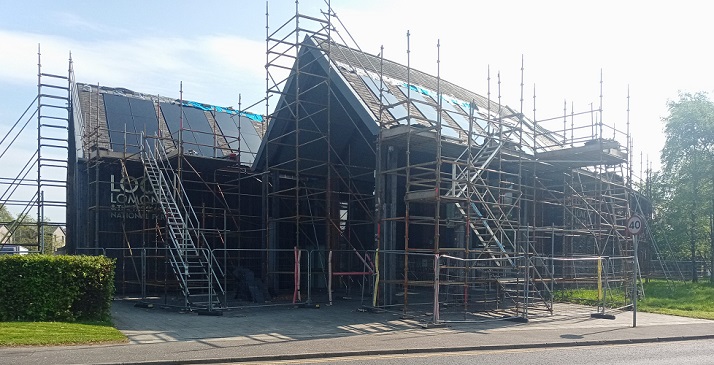
Could senior management at the LLTNPA have been using the term “snagging” like HIE did with the funicular (see here) to cover up the truth?
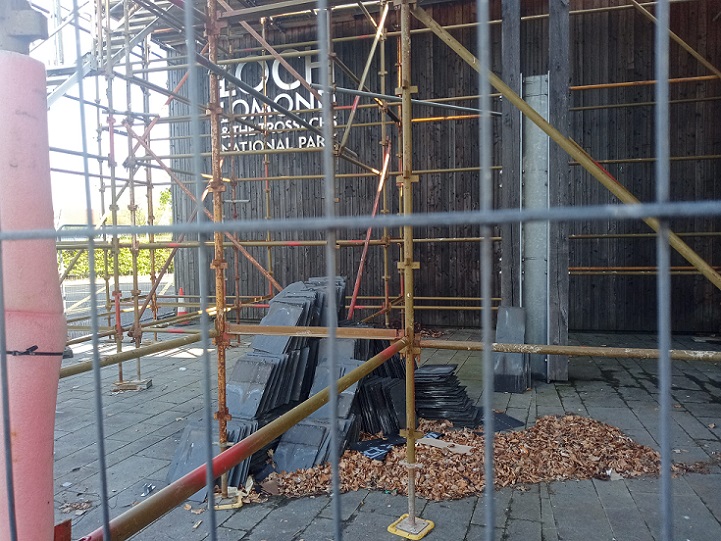
If a robust contract had been in place one might have reasonably expected the contractors, DCF Joiners and Building Services for the heat pumps and Shire Energy Services Ltd for the PV panels,to have faced penalties for late completion of the works and to have had staff on site around the clock to get the work done. There was no sign of that.
The cost of the delays
The scaffolding will be costing a large amount of money – one wonders who will be paying? – but the closure of Carrochan for six months will have saved the LLTNPA significant fuel and other operational costs.
This will be at the expense of their staff, forced to work at home whether they like it or not, unless the LLTNPA have given them additional allowances to keep warm over the winter. And its not just their staff, as the LLTNPA now shares its HQ with a number of other organisations:
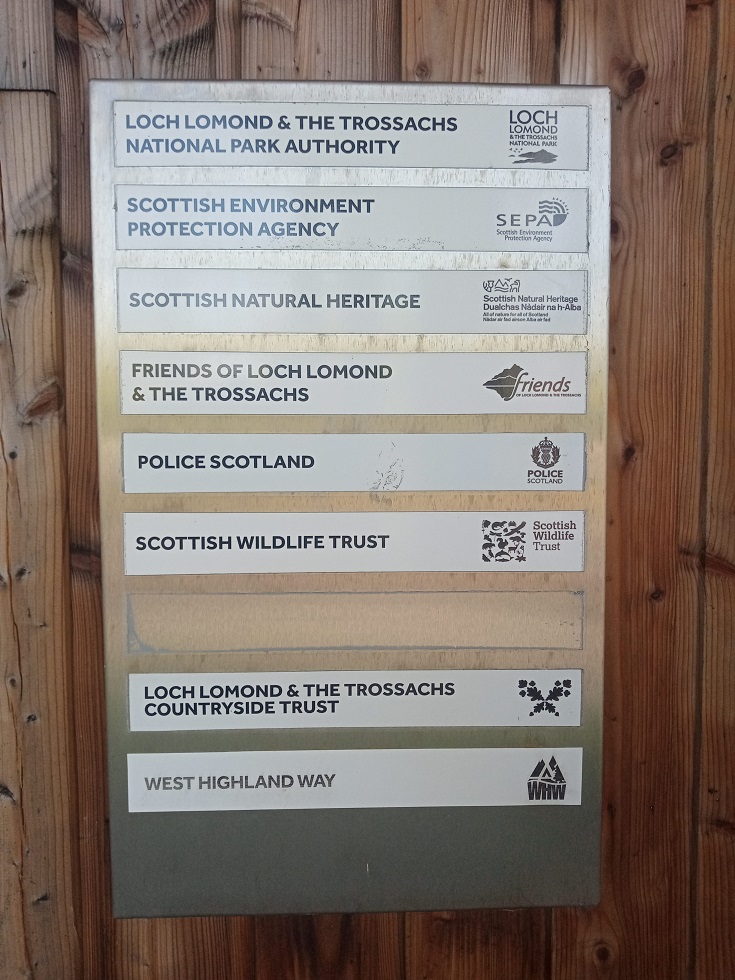
The human cost to the workforce is likely to be even more significant. Isolation has a serious impact on mental health and morale, severely affects organisational learning (staff can’t just simply walk over to another desk to get an answer to a question or discuss an issue) and almost certainly lowers productivity of staff. The Cairngorms National Park Authority recognised some of this last week when their Resources Committee considered a new organisational development strategy that aimed for office based staff to work at least 50% of their time in their premises rather than at home (see here). Among the points that Strategy made was that the need for “A senior management team that is visible and accessible”.
That hasn’t existed in the LLTNPA now for over six months – however many meetings have been held on Microsoft Teams that does not make up for lack of personal contact and space to create effective working relationships.
What’s gone wrong?
Unlike the CNPA,the LLTNPA Board treats staffing matters almost entirely as an operational matter, which it leaves to its all-powerful Chief Executive, Gordon Watson. The Board has no resources committee to consider or oversee either staffing or project management issues. The consequence is there is likely to have been a consider increase in staff dissatisfaction and a considerable reduction in staff productivity over the last six months and no means for the Board to respond to this.
On past form, LLTNPA senior management will try to cover up what has gone wrong, just as they have with many other examples of disastrous project plans and building management: the large cost overrun for the Loch Lubnaig visitor facility; the failed water supply at the Loch Chon campsite (see here); the disastrous lease for the former National Park visitor centre in Balloch (empty but which could now be being used by staff) and the Luss Visitor Centre (see here) etc etc. This is not an isolated example of project failure.
It was partly to conceal these failures that about 10 years ago the LLTNPA ceased to publish its Risk Register and started to conduct most of its business about how it was managing its estate in secret board sessions. That in my view has been an important contributing factor to the highly critical internal audit report by Glasgow City Council on the LLTNPA’s management of its assets (see here). This is dated November but was only considered by the LLTNPA’s Audit and Risk Committee in March. That report – despite its extraordinary front cover showing the Tron in Glasgow and its failure to consider the causes of the problems – found an almost complete lack of basic governance:
“Whist [sic] there is some asset management performance information reported to the Board, the current information does not include tracking the progress of the delivery of the [Asset Management] Strategy objectives. We were advised that this will be introduced once the corresponding plans have been developed.”
One wonders if there was a plan for the Carrochan “retrofit” and who on the board saw this?
The internal audit Report went on to recommend that “asset management performance information is reported to senior management and the Board” but not that this should be done openly to enable critical public oversight of what are supposed to be public assets. It will be interesting to see if the next meetings of the LLTNPA Board and its Risk and Audit Committee, which are due in June, will consider reports of what has gone wrong in open session or behind closed doors.
The LLTNPA has also completely failed to explained why this retrofit, of what was supposed to be a building “green to its core” was ever needed – its website (see here) still says this:
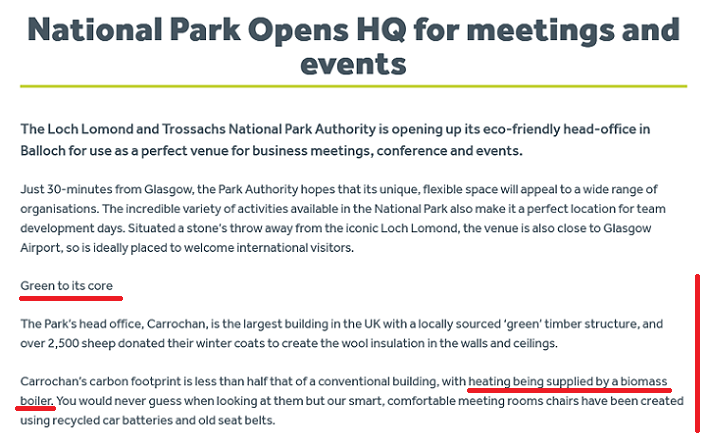
Its tempting to speculated that the Scottish Government’s revised building regulations, which banned wood burning stoves in new houses, and the desire to be seen to politically correct played a part in the decision to replace the biomass heating system which has been criticised locally (see here)? I have heard, however, on reliable authority that there has been significant problems with both the biomass heating system and the design of the building, a consequence of yet more past failures in asset management which the LLTNPA has been keen to cover up.
The LLTNPA’s recently adopted new target for reaching net zero across the National Park by 2034 almost immediately became redundant after the Scottish Government abandoned its policy off trying to achieve a 70% reduction in carbon emissions by 2030 (see here). Instead of doing anything serious to reduce carbon emissions in the National Park – e.g by improving public transport or reducing damaging forms of land-use – the LLTNPA chose to focus on reducing the carbon emissions of its own operations. That strategy too now appears to be in a state of collapse.
There is a pressing need for an independent review of how the LLTNPA has been managed since it was set up including the role played by civil servants in the Scottish Government. This was something that was supposed to happen in the second stage of the review of our National Parks that was quietly abandoned over ten years ago. The financial and human cost of that failure to scrutinise the LLTNPA has been considerable.
The cost of delays in the re-opening of LLTNPA Headquarters (Carrochan) also includes the hire of Balloch Church Hall on numerous occasions for Board and Planning & Access Committee meetings. Like LLTNPA staff surely “the former National Park Visitor Centre in Balloch” could have been used for these meetings. Of course, who knows what state the interior of said building is now. Has it been maintained since it was last vacated; has it been heated since then to aid preservation of the building; is it on the ‘at risk register’ or indeed habitable? These are also questions requiring investigation and answers. Given that Balloch is hailed by LLTNPA as the Gateway to the National Park, I have never understood the reasoning (other than monetary) why the Visitor Centre as such was closed. It was in itself an attraction for visitors to Lomond Shores. The structure itself was built to emulate LLTNPA Headquarters Carrochan in style: the exterior was wooden clad and the interior open and lofty. It contained interesting and informative interactive picturesque exhibits worthy of visiting many times over. I have often wondered what became of them. There is no sign of them having been removed to Balmaha Visitor Centre. Another waste of resources!! Personally speaking, I am of the opinion that the Interim Committee had much more talent, expertise, common sense and awareness of what a National Park should be about than any of the incumbents following on.